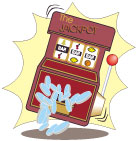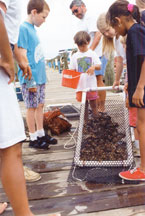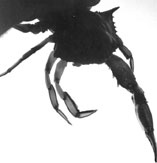Best Talk around Town
Readers’ Choice: Slots — which readers also rank as Worst Use of Public Funds
 No wonder! There’s nothing America loves better than technology, and today’s “video lottery terminals” are technology at its more alluring. The hypnotic spin of the cylinder. The whirl of bright colors. The addiction of the intermittent reinforcement schedule. The clatter of coins. You’ve got to love slots or hate ’em.
No wonder! There’s nothing America loves better than technology, and today’s “video lottery terminals” are technology at its more alluring. The hypnotic spin of the cylinder. The whirl of bright colors. The addiction of the intermittent reinforcement schedule. The clatter of coins. You’ve got to love slots or hate ’em.
On top of that, politicians came to life over slots. Staking their ground and, slugging it out like pugilists. And they’re still doing it. What fun!
Now to the more serious question of whether Maryland should bring in the slots — at least to serving up the lion’s share of the bounty to racetrack owners who haven’t proved they can run the business they’ve got: Forget that, Bay Weekly readers said.
Editors’ Choice: Smart Growth
Alas, Smart Growth hasn’t been quite smart enough. First, its creator, Gov. Parris Glendening, failed to win over the hearts and minds of citizens. Sure, targeting public infrastructure funding to already developed areas — thereby making it more costly to develop our remaining open areas — sounds good. But all we heard was talk. Who could see the results? An effective campaign would have shown us Smart Growth’s good works. Don’t get us started: We’ll give you dozens of how-it-could-have-been-done ideas).
But that never happened. As a result, when new Gov. Robert Ehrlich started amputating bits and pieces of his predecessor’s pet project, nobody knew whether it mattered or not.
 Best Use of Public Funds
Best Use of Public Funds
Readers’ Choice: Snow removal
The Presidents’ Day blizzard of 2003 is one for the record books, shutting down businesses along the Bay and barricading people in their homes behind three-foot walls of snow. Shutting down schools for more than a week, it was a favorite with kids — until they had those snow-days tacked on to the start of their summer vacations.
But for those of us who have to work for a living, the novelty wore off after the first or second day away from the job. Shoveling became a full-time career, the goal being to reach the street where snowplows had to make two, three, even four passes. Anne Arundel and Calvert counties as well as Annapolis quickly depleted their snow removal funds, racking up hundreds of thousands of dollars in already tight budget times.
But Bay Weekly readers agreed that this was money well-spent by our local governments. Otherwise we’d only now be digging out of the white stuff at the end of our driveways.
Editors’ Choice: The 2012 Summer Olympics Bid
Perhaps you’ve already forgotten the combined efforts of Maryland, Washington and Baltimore to lure the 2012 Summer Olympics to the area. In the end, New York City (can anyone say 9/11?) won the nod as the U.S. contender. Before that, Baltimore dropped out to leave D.C with a stronger hand. Even so, had Washington won the right to host the Olympics, the Bay would have been the big winner, with all sailing events held on the Chesapeake and with Beach Volleyball down at Sandy Point State Park.
Imagine, if you can, the crowds, the cameras, the reporters from all over the world. Some would say that the area couldn’t handle such a volume of people. That’s what they used to say about the U.S. Sailboat and Powerboat Show. And about the Whitbred/Volvo Around the World Race.
Events like these and the Olympics bring money to their hosting communities. More important, still, is the worldwide attention these events garner.
The world already looks to Chesapeake Bay as a model for restoration. But perhaps if the world saw how far we have yet to go, the Bay would be on the real way to recovery.
Best Charity Fundraiser
Readers’ Choice: Rod ’n’ Reel’s Cancer Gala
Since 1982, Southern Marylanders have come together to celebrate life at Rod ’n’ Reel’s annual Cancer Gala, in support of the American Cancer Society. So great is their support that citizens and sponsors routinely contribute a quarter of a million dollars, with each year topping the previous record. All that money goes to fight cancer through local support, state research and national collaboration.
That’s how it was once more this year. On August 7, thousands of folks joined together at the water’s edge in Chesapeake Beach for food and drink, music and dance, good times for a good cause.
Editors’ Choice: Relay for Life
A good fundraiser needs three things: It rises from the community, raises money for a cause and gets people involved. On all three scores, Relay for Life excels.
Relay for Life is the American Cancer Society’s staple event. Each community or county has its own Relay, so it’s close to the people. Relays are generally overnight and can last as long as 24 hours. Teams formed from schools, businesses, work, friends and clubs camp out at a local high school or field and walk the track. Each team keeps at least one member on the track at all times.
“Relay means to me that money is going toward research in hopes that it will help people live a longer life,” says Barbara Sturgell, owner of Happy Harbor in Deale and a team sponsor. Sturgell and her family have personal ties to the fundraising event, which means they’ve suffered losses, but they have not lost hope. “We even involve the little ones who are two and three years old,” says Sturgell. She adds that “Relay is very emotional but is also a very personal experience.”
Relay for Life brings those grieving together for strength and encouragement and for those fighting together to celebrate and embrace life. For cancer patients in treatment, Relay is a time to gain support. And for survivors, it’s a time to spread hope.
To learn more: 800/ACS-2345.
 Best Effort to Improve the Bay
Best Effort to Improve the Bay
Readers’ Choice: Oyster seeding
This summer weve been served serious reminders — from the Bay’s expanding dead zone to fish kills to algae bloom — that nutrient pollution is far too pervasive and undermines efforts to protect and restore our national treasure.
Once the Bay’s most valuable fishery, oysters were so plentiful they could filter the entire Bay in just a few days.
But now the Chesapeake’s native oyster population is a dismal two percent of its abundance compared to John Smith’s time. Bay Weekly readers are right on the money acknowledging the importance of restoring native oysters. The filtering and habitat benefits alone make native oyster restoration essential to any plan to improve water quality, especially if we’re to meet the Bay-wide goal of increasing native oysters tenfold by 2010.
 Editors’ Choice: SAV plantings
Editors’ Choice: SAV plantings
Bay grasses (SAVs or submerged aquatic vegetation) filter pollution, reduce erosion and provide food and habitat to scores of animals. Underwater grasses are perhaps the single best indicator of water quality because they require clean and clear water to survive.
One of the reasons blue crabs — today the Chesapeake’s most commercially valuable fishery — are in decline is lack of underwater grass habitat critical to its life cycle. Researchers found that crab populations are 30 times more dense in vegetated areas than in unvegetated areas. Young crabs molt and hide from predators in these underwater meadows. If we want a healthy Bay, we need more underwater grass beds.
Issue Needing More Attention
Readers’ Choice: Bay Pollution
Once again, our readers have voted on target. In this year of tight money, we thought readers might feel the pinch and vote for economic growth. But in concluding that pollution is the biggest issue in our region, our readers affirmed their certainty that Chesapeake Bay is the life force vitalizing our region. We’ve made some strides toward Bay restoration. But not nearly enough.
As Naval Academy professor Howard Ernst documents in his new book, Chesapeake Bay Blues, the signs are everywhere: the Columbia-like decline of oysters and crabs in recent years, Bay-choking nitrogen — from sewage treatment plants, farms and lawn-chemical junkies; contaminants in every fish tested; a billion and a half pounds of manure produced by the Eastern Shore chicken industry, spread on fields and leaking into our waterways.
The answer, Ernst says, is for each of us to insist that Bay recovery be Maryland’s first political priority. In the news this week, Chesapeake Bay Foundation — which gets a share of the blame Ernst hands out — has demanded a new federal-state compact with legal and binding authority.
Editors’ Choice: Sprawl
We’ve seen the enemy and he is us. There’s not a problem afflicting the Bay that doesn’t have its roots in human occupation of Chesapeake Country. The more of us who come, the more new land we colonize, the more cars we drive, the more seafood we demand, the more lawn we plant, the more sewage we produce — the bigger the stress the Bay feels.
What to do about this enemy? The best answer we’ve seen to sprawl was Gov. Parris Glendening’s Smart Growth program. For more on that, see Best Talk of the Town.
Best Thing to Happen to the Bay
Readers’ Choice: Limits on Crabs
Maybe our readers love a crabfeast. Perhaps their worry has something to do with part of Maryland’s heritage disappearing before their eyes. Whatever the case, our reader’s surprised us by picking a somewhat downbeat “best thing” — the imposition of new crabbing rules.
 It’s scary, we know. And we’re heartened that crab-lovers, many watermen and tuned-in folks understand that what is happening with declining water quality and overharvesting requires pain (such as paying $60 a dozen for the big guys). Even balky Virginia has shortened its season, giving us hope that more crabs can make it up the Bay.
It’s scary, we know. And we’re heartened that crab-lovers, many watermen and tuned-in folks understand that what is happening with declining water quality and overharvesting requires pain (such as paying $60 a dozen for the big guys). Even balky Virginia has shortened its season, giving us hope that more crabs can make it up the Bay.
Tough choices always trigger tough politics, and some of those restrictions have been scaled back. But we toast our readers nonetheless for their public spirit and their willingness to back more regulation. Maryland’s world-class success in restoring rockfish is a talisman to hold onto these days, a reminder that tough times can be overcome by a combination of human force of will and nature’s capacity to repair itself.
Editors’ Choice: Hmmmm … that’s a tough one. A year of heavy rains and bad water has put the hurt on Mama Chesapeake. Our choice is a tie: (1) People’s understanding (as demonstrated above) of the Bay’s plight and; (2) Mars’ beautiful visit to the Bay this month — the closest it will come for nearly 300 more years — an omen to us that good things lay ahead.
Worst Thing to Happen to the Bay
Readers’ Choice: Gov. Robert Ehrlich
Whoa … this is a tricky one. We here at Bay Weekly don’t endorse candidates but we darn sure talk about politics, and what’s happening under Ehrlich will be testing all the Marylanders who say the Bay and the environment are dear to them.
 And not just the environment: Ehrlich brings an approach to governing like most Marylanders never have seen: a fewer-rules, get-lost government, rah-rah-Big Business, Libertarian view. Change has become the mantra of politics, and Marylanders were caught up in it last election after eight years of a bland fellow named Glendening whose accomplishments became overshadowed by ditching his wife and picking spats. His anointed one: a Kennedy clueless about running a campaign. Along comes Mr. Handsome Devil from Congress and a species of GOP not generally known in these waters — an ardent conservative who doesn’t preach about values — and BOOM … a political explosion up there on the seismic scale.
And not just the environment: Ehrlich brings an approach to governing like most Marylanders never have seen: a fewer-rules, get-lost government, rah-rah-Big Business, Libertarian view. Change has become the mantra of politics, and Marylanders were caught up in it last election after eight years of a bland fellow named Glendening whose accomplishments became overshadowed by ditching his wife and picking spats. His anointed one: a Kennedy clueless about running a campaign. Along comes Mr. Handsome Devil from Congress and a species of GOP not generally known in these waters — an ardent conservative who doesn’t preach about values — and BOOM … a political explosion up there on the seismic scale.
Our readers seem to be saying that there’s less to Ehrlich than a pretty face, at least when it comes to the Bay. His choices to run environment and resources offices have been roundly condemned. He’s been outed for abandoning Smart Growth and land-conservation policies. He’s written the “wise-use” mantra of extremists in his DNR mission policy. Other than that, “How was the play, Mrs. Lincoln?”
But we see a sliver of hope, yes we do. Ehrlich’s best-defined environmental promise was stanching the flow of nitrogen into the Bay. Coincidentally, this damage from nitrogen pollution has emerged as one of Maryland’s biggest problems right now — not just an environmental woe. So, we hope, our football-hero governor will decide to win one for the state. (And not just because Mayor O’Malley up in Baltimore is waiting in the wings to kick Ehrlich’s butt back to Arbutus.)
Editors’ Choice: The Attack of the Green Blob
That’s the huge flow of nitrogen and supernutrients from farms, worn-out sewage treatment plants and the excess of green lawn-loving folk that is killing oxygen, choking aquatic life to death and producing toxic-green algae making swimmers sick and itchy.
to the top

